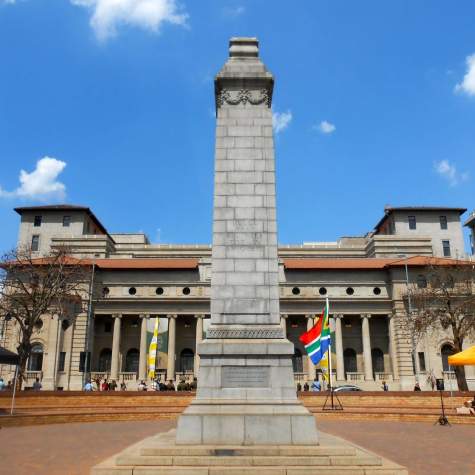The Cenotaph is an inclusive war memorial, having been rededicated to all South Africans who died for freedom in all wars and conflicts. Since the monument’s inception in 1926, it has been the focal point for the annual National Remembrance Sunday Service, the main memorial service of its kind in South Africa. The Cenotaph is a prime commemorative site by virtue of its prominent location in the city’s civic and historical heartland; its long historical associations; and the acceptance it has gained in the post-apartheid period among war veterans from all sections of the population.
The Cenotaph is constructed of grey granite with inscriptions v-cut into the stone. It occupies the center of the eastern portion of Beyer’s Naudé Square. On 10 October 1926, it was unveiled by the Governor-General, the Earl of Athlone. The monument is a replica of the Cenotaph in Whitehall, London, designed by Edwin Lutyens*. It was hoped that the memory of the Great War would somehow prevent such slaughter from happening again. The day after the Market Square ceremony, a leading article in The Star expressed the hope that if the two memorials would “strengthen our determination to prevent as far as is humanly possible, the repetition of the tragedy, then the War would not have been a waste of precious lives”.
But 21 years later on 18 February 1947, The Star carried a picture illustrating one of the ironies of history: a mason preparing the stone of the Cenotaph for the dates of another world war! The stone mason was chiseling away the inscription 1914-1919 to make place for the dates of another bloody conflict – the Second World war of 1939-1945. The inscription was replaced by the words, “Our Glorious Dead, 1939-1945” and the dates 1914-1919 were placed higher up on the Cenotaph under the inscription “Erected to the memory of the men of Johannesburg who laid down their lives in the Great War”. During the Royal visit of April 1947, King George VI unveiled new inscriptions commemorating those who had died in World War 2.
In 1996 the Cenotaph was rededicated in honour of all South Africans who died in wars and conflicts, including the struggle for democracy.
(Excerpts from the City of Johannesburg Inventory Form)
* There is confusion over who the architect was. Some sources say Lutyens while others say it was Harold Porter. The latter has been entered under construction details as this is the opinion of Clive Chipkin.
Rating:
Builder:
Architect:
Architectural Firm:
Declaration Status:
Not Declared
Blue Plaque:
No
Construction Date - Completion:
1926
Circa:
1920-1929





